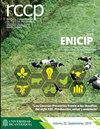Effects of non-genetic factors on milk yield and chemical composition of milk from Holstein-Friesian cows
IF 0.5
4区 农林科学
Q4 AGRICULTURE, DAIRY & ANIMAL SCIENCE
引用次数: 0
Abstract
25 Background: In order to accurately determine the performance of cows in terms of milk yield 26 and milk components, it is necessary to determine the extent and direction of environmental 27 factors. Although many studies have explored environmental factors affecting milk yield, there 28 is not enough information about the effects and direction of environmental factors on the 29 composition of milk. Objective: To determine the effects of non-genetic factors, such as 30 calving season, lactation number, lactation stage, animal age, and herd size on milk yield, the 31 chemical composition of raw milk, and Somatic Cell Count (SCC) in Holstein-Friesian cows. 32 Methods: Data were obtained from 15,354 raw milk samples of 5,118 Holstein-Friesian cows 33 at 276 dairy farms in Türkiye. The data analysis was performed using the General Linear Model 34 (GLM) feature of the SPSS statistics program. Results: Mean fat (F), protein (P), dry matter 35 (DM), lactose (L), urea (U), and Log 10 SCC values of cow milk were 3.74 ± 0.01, 3.19 ± 0.01, 36 11.36 ± 0.03, 4.32 ± 0.01%, 21.57 ± 0.28 mg/dL, and 5.244 ± 0.01 cells/mL, respectively. Peak 37 milk yield (PMY), lactation milk yield (LMY), 305-day milk yield (305-d MY), and SCC 38 values were found to be 33.7 ± 0.13, 8,538.33 ± 89.64 kg, 6,479.42 ± 168.96 kg, and 224,164.34 39 ± 4,402.79 cells/mL, respectively. Conclusion: It is recommended to take measures to improve 40 the protein, dry matter, and urea component of milk in dairy farms in Türkiye and investigate 41 in detail the relationship between raw milk urea component, subclinical mastitis, and 42 reproductive features.非遗传因素对荷斯坦-弗里谢奶牛产奶量和牛奶化学成分的影响
本文章由计算机程序翻译,如有差异,请以英文原文为准。
求助全文
约1分钟内获得全文
求助全文
来源期刊

Revista Colombiana De Ciencias Pecuarias
AGRICULTURE, DAIRY & ANIMAL SCIENCE-
CiteScore
0.80
自引率
0.00%
发文量
18
审稿时长
6-12 weeks
期刊介绍:
The editors of Revista Colombiana de Ciencias Pecuarias (RCCP) welcome the submission of original manuscripts on experimental and clinical studies associated with the broad areas of animal sciences and veterinary medicine as they interface with biochemistry, molecular biology, physiology, pharmacology, toxicology, pathology, microbiology, parasitology, immunology and epidemiology. The scope of the journal includes studies of basic and applied research in animal management and production, feeding and nutrition, reproduction, breeding, genetics, animal welfare and behavior; as well as animal production focussed from biotechnology, soil science, agrostology, silvopastoral systems, livestock economics and the environment.
The criteria for acceptance of papers submitted for publication are originality, quality and clarity of the content. Each contribution must be based on original, unpublished research that has not been simultaneously submitted to other journals. All papers will be peer reviewed. All authors bear responsibility for ensuring the integrity and quality of their reported research. It is the author''s responsibility to secure permission to use figures or tables that have been published elsewhere.
Contributions may be classified as original research, review, rapid communication, clinical case studies or methodological articles, as well as news/commentaries or letters to the editor. Most review articles are invited by the editor. Authors interested in submitting a review article should contact the corresponding editor. Rapid publication of original manuscripts is a goal of the journal. Manuscripts must be written in English. Each manuscript is considered for publication with the understanding that it has not been simultaneously submitted to any other journal. Upon acceptance for publication, papers are subject to editorial review and revision.
 求助内容:
求助内容: 应助结果提醒方式:
应助结果提醒方式:


